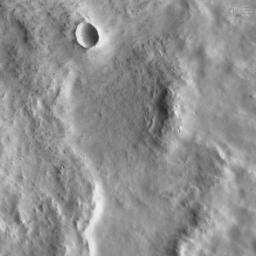
|
Fluidized Crater Ejecta Deposit
- Click the image above for a larger view
- Full-Res JPEG (1024 x 1024) (185.8 kB)
- Full-Res TIFF (1024 x 1024) (1.0 MB)
Caption:
The Mars Orbiter Camera (MOC) onboard the Mars Global Surveyor (MGS) spacecraft continued to obtain high resolution images of the red planet into August 1998. At this time, each ground track (the portion of Mars available for MOC imaging on a given orbit) covers areas from about 40°N on the late afternoon side of the planet, up over the sunlit north polar cap, and down the early morning side of Mars to about 20°N latitude. Early morning and late afternoon views provide good shadowing to reveal subtle details on the martian surface. Views of Mars with such excellent lighting conditions will not be seen by MOC once MGS's Science Phasing Orbits end in mid-September 1998.
The image shown here, MOC image 47903, was targeted on Friday afternoon (PDT), August 7, 1998. This picture of ejecta from a nameless 9.1 kilometer (5.7 mile)-diameter crater was designed to take full advantage of the present lighting conditions. When the image was taken (around 5:38 p.m. (PDT) on Saturday, August 8, 1998), the Sun had just risen and was only about 6° above the eastern horizon. With the Sun so low in the local sky, the contrast between sunlit and shadowed surfaces allowed new, subtle details to be revealed on the surface of the crater ejecta deposit.
The crater shown here has ejecta of a type that was first identified in Mariner 9 and Viking Orbiter images as "fluidized" ejecta. Ejecta is the material that is thrown out from the crater during the explosion that results when a meteor--piece of a comet or asteroid--collides with the planet. Fluidized ejecta is characterized by its lobate appearance, and sometimes by the presence of a ridge along the margin of the ejecta deposit. In the case of the crater shown here, there are two ridges that encircle the crater ejecta--this type of ejecta deposit is sometimes called a double-lobe rampart deposit. The MOC image shows that this particular crater also has "normal" ejecta that occurs out on the plains, beyond the outermost ridge of the main, fluidized ejecta deposit.
Fluidized or "rampart" ejecta deposits have long been thought by many Mars scientists to result from an impact into a surface that contains water. The water would have been underground, and could have been frozen or liquid. According to the prevailing model, when the meteor hit, this water was released--along with tons of rock and debris--and the ejecta flowed like mud. Images with resolutions higher than those presently attainable from the 11.6 hr elliptical orbit are needed to see the specific features (such as large boulders "rafted" by the dense mud) that would confirm or refute this model. Such images may be acquired once MGS is in its mapping orbit.
Background Info:
MOC image 47903 was received and processed by the MOC team at Malin Space Science Systems on Monday afternoon (PDT), August 10, 1998. The image center is located at 27.92°N latitude and 184.66°W longitude, in the northern Tartarus Montes region.
Cataloging Keywords:
| Name | Value | Additional Values |
|---|---|---|
| Target | Mars | |
| System | ||
| Target Type | Planet | |
| Mission | Mars Global Surveyor (MGS) | Mariner, Viking |
| Instrument Host | Mars Global Surveyor | |
| Host Type | Orbiter | Flyby Spacecraft |
| Instrument | Mars Orbiter Camera (MOC) | |
| Detector | ||
| Extra Keywords | Asteroid, Comet, Crater, Grayscale, Impact, Mountain, Shadow, Water | |
| Acquisition Date | ||
| Release Date | 2000-09-16 | |
| Date in Caption | 1998-08-07 | 1998-08-08 |
| Image Credit | NASA/JPL/Malin Space Science Systems | |
| Source | photojournal.jpl.nasa.gov/catalog/PIA01330 | |
| Identifier | PIA01330 | |
